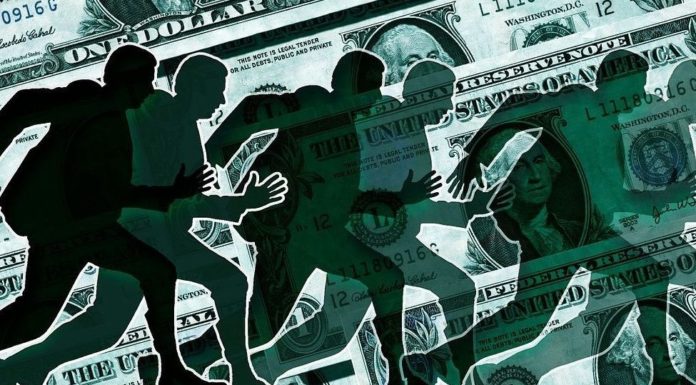(Mike Holly, Mises Institute) The conditions have now aligned for a repeat of the major stock market crashes that have occurred since the founding of the US Federal Reserve Bank (Fed) in 1913. Considering their vast experience and resources, the Fed has to know that their plan to control inflation by raising interest rates rapidly and significantly since 2022, and also tightening credit this year, will likely result in another major crash. Although the Fed has issued vague warnings about the impending pain on the stock market and economy, they have not explained how and why they will again wipe out trillions of dollars of wealth of unsuspecting investors.
As Marty Zweig, a successful Wall Street investment adviser known for data studies, warned, “Don’t fight the Fed,” because the central bank largely controls the direction of the stock markets. Generally, the major stock market booms start with the Fed stimulating slow economic growth by lowering interest rates, often while the government increases deficit spending. As Austrian business cycle theory predicts, this results in asset price inflation (e.g., stocks, houses, etc.), and sometimes also consumer price inflation. The major busts result when the Fed seeks to control the inflation by raising interest rates significantly, while the government reduces deficit spending.
The following graphs demonstrate the strong inverse relationship between the Dow stock market index and interest rates largely set by the Fed (i.e., stocks values inflate when interest rates are lower and deflate when higher). The top graph from Macrotrends shows the Dow Jones stock market index on a logarithmic scale and adjusted for today’s dollars over time. The bottom graph from the Fed shows interest rates over the same time. These graphs can be used to locate the major stock market cycles and analyze the effects of interest rates along with deficit spending in causing booms and busts.

The Dow Jones stock market can be considered to be in its sixth major boom and bust cycle. The first cycle had a 1913–15 boom and 1915–20 bust. The second cycle had a 1920–29 boom and 1929–32 bust. Then, there was a 1932–50 period that was effectively absent of major booms that could go bust. The third cycle had a 1950–65 boom and 1965–82 bust. The fourth cycle had a 1982–2000 boom and 2000–2002 bust. The fifth cycle had a 2002–7 boom and 2007–9 bust. The sixth cycle had a 2009–22 boom and a bust starting in 2022. The five major stock market crashes can be considered to have started in 1915, 1929, 1965, 2000, and 2007, with another likely in 2022.
1915—As the Fed started cutting interest rates in 1913, the Dow stock market climbed and peaked in 1915. That year, the Fed started raising rates and the stock market dropped in 1916. During 1917 and 1918, deficit spending for World War I, while interest rates were flat, caused rampant inflation and a spike in stock prices. After the war, the Fed rapidly raised interest rates in 1920 to cause a stock market crash and the depression of 1920–21.
1929—After the Fed cut interest rates from 1921 to 1925, the so-called roaring ’20s brought a booming Dow stock market from 1921 to 1929. After the Fed started raising interest rates in 1927, the stock market crashed in 1929 and the economy tanked. During the 1930s, the Fed cut interest rates, but President Franklin D. Roosevelt resisted deficit spending after 1932. The Fed even raised, before lowering, interest rates in 1935 to cause stock market losses and the recession of 1937–38. These policies prolonged the Great Depression until World War II, if not longer.
1965—Deficit spending during World War II, along with low interest rates during and after the war, helped bring a postwar boom with economic recovery, consumer price inflation, and stock market gains. During the late 1960s and 1970s, the government accommodated inflation by raising interest rates slowly over a relatively long time period. This caused a long, flat stock market with sharply declining real values (due to inflation) from 1965 to 1982. Finally, the Fed raised interest rates rapidly and high around 1978 to cause a severe recession in the early 1980s.
2000—After 1981, the Fed started cutting interest rates and the government increased deficit spending, especially on defense. The stock market boomed. The Fed raised interest rates starting in 1993 and even higher in 1999 to stop what was claimed to be the “irrational exuberance” of the booming stock market, while the US government ran budget surpluses from 1997 to 2001. The stock market, especially tech, crashed in 2000, and the economy receded during the recession of 2001.
2007—In 2001, the Fed started cutting interest rates and loosening credit on home loans while the government increased deficit spending. The stock market boomed back to its prior peak (in 2000) and home prices inflated. From 2005 to 2008, the Fed raised interest rates and the government decreased deficit spending. In 2007, the stock market and home prices crashed. The economy suffered through the Great Recession until 2009.
2022—Since the start of the Great Recession in 2007 and until 2022, the Fed has lowered interest rates to near zero while the government increased deficit spending. This has accommodated asset and consumer price inflation. Since March of 2022, the Fed has quickly raised interest rates by about five percentage points.
Today, the Fed is clearly still concerned about the inflation. However, higher interest rates have already led to a financial crisis among the banks. Experiences with past markets indicate that, if the Fed continues to fight inflation, the stock markets will likely crash, like they did twice in both the early 1900s and early 2000s.



